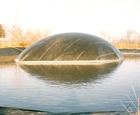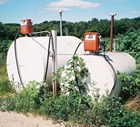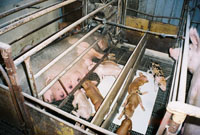Agricultural Properties

Methane bubble caused by leaking manure pit
An agricultural property may be a working farm (including the farmstead, hundreds of acres of tillable land, wooded land and pastureland) or it may just be a few acres of former farmland slated for development.
Phase 1 ESAs of agricultural properties have unique challenges because there are usually few records available. Most of the information about the current and past activities conducted at these types of properties must be obtained from the current and former owners, the children of deceased former owners or the farmers who have leased the land. Old farm dumps are always a concern at agricultural properties. However, most of the potential environmental concerns are usually found on the two to four acres that include the farmhouse and farm buildings.
Common environmental concerns at agricultural properties

Contaminated soil between aboveground fuel tanks
- Leaking underground fuel tanks and spillage near aboveground fuel tanks
- Improper storage or disposal of waste oils and solvents
- Old private water supply wells that have not been properly abandoned
- Manure pits that may be leaking
- Asbestos-containing materials inside old farmhouses and milk houses and on the roofs of old farm buildings
Project Spotlight Segregated Early Wean Hog Farm, Wisconsin Dells, WI

A Phase 1 ESA of a hog farm in Adams County, Wisconsin determined that it had been a dairy farm until 1973. The current owner, and his father (the previous owner), both stated that no underground fuel tanks had ever been at the property. However, a man who had lived with his parents at the farm from 1955 to 1973 when it was a dairy farm reported that there had been an underground gasoline tank at the property before it was sold to the father of the current owner. Possible contamination of the private water supply well at the farm became a concern when it was determined that the well was less than 50 feet deep and was located downgradient from the old underground gasoline tank. Therefore, in addition to other items, the Phase 1 ESA recommended that a water sample should be collected from the water supply well and analyzed for bacteria, common agricultural pesticides and volatile organic compounds.